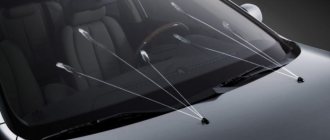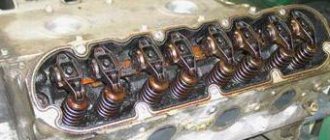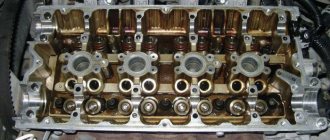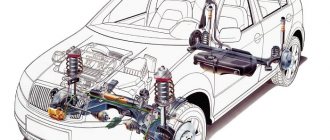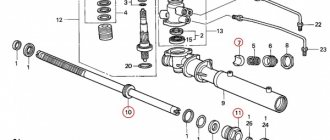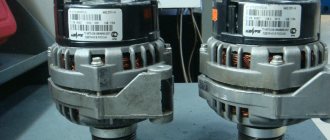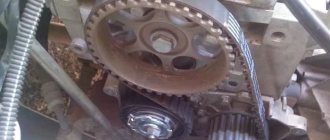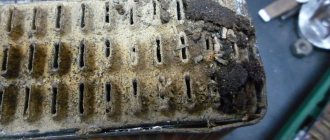One of the first internal combustion engines with hydraulic compensators was installed on a Cadillac car back in the 30s of the last century. But “hydrikis” became truly in demand only decades later, largely due to the expansion of the Japanese automobile industry. Their use in the operation of the gas distribution mechanism (GRM) led to the complication of engine design, but also significantly simplified maintenance.
- What is this
- Why is it needed?
- How does it work
- Why is it knocking?
- How to check
- How to prevent breakdown
Camshaft location
Modern cars most often use a mechanism with an overhead camshaft, which has reduced the metal consumption of the structure and, as a result, increased reliability.
Since metal expands when heated, and the valves are constantly in a high-temperature zone, to prevent it from being pressed in, as a result of which it does not fit tightly into the seat, a thermal gap is provided between the valve stem and the camshaft cam.
In this case, the thermal gap has a certain value to ensure the maximum possible opening of the valve, eliminating its tightening.
Previously, on engines with an overhead camshaft, the thermal clearance was adjusted by placing shims of a certain thickness between the valve stem and the camshaft cam.
The disadvantage of using these washers was the need to periodically check the gap and adjust it by selecting washers.
Nowadays, to ensure thermal clearance, hydraulic compensators are increasingly being used, popularly known as hydraulic compensators, the use of which eliminated the need to adjust the gap, and all because the gap is adjusted by oil pressure.
Hydraulic compensators, like shims, are located between the valve stem and the camshaft cam.
Externally, the hydraulics look like a small piston, so the head has seats for them.
Severe mechanical wear
If the car has high mileage and the hydraulic compensators have not been changed for a long time, knocking noise from them may be due to excessive wear.
A visual inspection will help you understand how to identify a knocking hydraulic compensator. If the impact surface is worn, the knocking hydraulic compensator will be visible immediately by the dents from the camshaft. If all the hydraulic compensators look normal outwardly, you need to press them one by one with a piece of wood or a screwdriver. The effort should be the same. In this way, you can identify both a jammed hydraulic compensator and one that is not holding pressure.
Design and operating principle
The design of the hydraulic compensator itself is simple. It consists of a cylindrical piston, the bottom of which receives the force from the camshaft cam.
Inside this piston, a plunger is installed in its seat, through which force is transmitted through the piston from the cam to the valve stem (see photo above).
The plunger moves freely in its seat, providing a thermal gap.
The hydraulic valve works like this: when the engine is running, the cam runs up against the bottom of the hydraulic compensator piston and moves it down. While moving, the piston presses on the valve through a plunger, and it opens.
The gap is adjusted using oil.
The oil pump supplies working fluid to the head under pressure. In the hydraulics, it enters the space below the plunger and displaces the plunger inside the seat.
The higher the oil pressure, the more it will put pressure on the plunger and the more it will come out of its seat.
When the pressure decreases, the plunger enters the seat again. Thus, the thermal gap between the plunger and the valve stem is independently regulated and depends on the pressure in the lubrication system.
To prevent oil from flowing out of the hydraulic compensator after stopping the engine, ball valves are installed in the oil supply channels in the cylinder head.
Having the advantage of no need for adjustment, the hydraulic compensator also has one significant drawback - high sensitivity to engine oil.
How to fix?
What to do if the hydraulic compensators suddenly start knocking? First of all, the car enthusiast needs to recognize the reason. If the oil is to blame, it is better to replace it. It is worth choosing semi-synthetics. Initially, you can try flushing the engine with a special liquid. Their variety is great. The basis of flushing fluids is mineral oil. Alkaline additives are added to it, which are designed to clean the engine walls of unnecessary dirt. Now there are two types of such liquids on the market: the so-called fifteen-minute liquids and long-term liquids. Flushing is usually carried out before changing the oil. If this procedure does not get rid of the knocking, you need to think about it. In the event of an intake malfunction, it is necessary to replace the oil with oil with a lower viscosity, flush the engine and replace the hydraulic compensators. It is better, if you do, to change everything at once, rather than just one. Even if it's just out of order. If the oil filter is clogged, it can also be replaced. This way the knock can be eliminated.
Causes of knocking hydraulic compensators
The hydraulic compensator is still not an adjusting washer, which can only decrease in thickness due to constant friction; it may well fail.
Problems with the operation of the hydraulics manifest themselves in the form of a clearly audible knocking sound during operation of the power plant. Moreover, the knocking may occur in some engine operating modes, but in others it disappears.
Also, the knocking of hydraulic compensators can appear when the engine is not warmed up and disappear after reaching the optimal temperature, or vice versa.
The most common cause of hydraulic knocking is engine oil, although there are quite a few other causes.
If, when starting the power plant, a knocking sound is heard from the hydraulic compensators, but it quickly subsides, this is not the reason for their failure.
It’s just that after the next stop of the power unit, some of the valves remain squeezed out due to the location of the camshaft, the oil supply channels also remain open and the working fluid from the hydraulic fluid flows through them.
When starting, the amount of oil in the channels is quickly replenished.
But if knocking on a cold engine continues for a long time or until the engine is completely warmed up, this indicates a malfunction.
The hydraulic compensator knocks when cold.
Knocking when cold may indicate:
- Mechanical wear of the plunger and its seat. In this case, the working fluid does not maintain its pressure and constantly flows out of the sub-plunger space;
- Jamming of the plunger in the seat due to contamination;
- Ball valve jamming in the open position due to contamination;
- Oil supply channel clogged. When warmed up, the blockage is washed out by flowing oil and the hydraulic compensator works normally;
- Use of high viscosity oil in cars. When the engine is running cold, viscous oil simply does not have time to enter the hydraulic compensator;
- Exhausted oil life, as well as significant contamination with friction products;
- Significant clogging of the oil filter, as a result of which its throughput drops, and cold oil is not supplied in full to the cylinder head.
The reasons for the knocking of hydraulic valves on a cold engine are in many ways similar to the reasons for their knocking on a hot one.
Knock of the hydraulic compensator on a hot engine.
The appearance of a knock may be due to mechanical wear, jamming of the plunger or valve.
Regarding the oil, it is worth noting that knocking when hot can be due to highly fluid oil, then the oil pump cannot provide the proper pressure.
Another reason for knocking, both cold and hot, may be wear of the oil pump with a subsequent drop in its performance.
Repair
Not every hydraulic pusher can be restored to working condition. But sometimes the replacement period can be noticeably delayed. Sometimes you can't do without it. The spare parts catalog does not always contain the required item. There are at least 3 ways to extend the life of the pusher:
- Mechanical cleaning. It will take time and considerable skill to disassemble the cylinder head and remove the hydraulics. But the result will be noticeable immediately. No need to pour chemicals into the engine.
- Changing the filter and oil. During the procedure, the system should be flushed in the traditional way. To do this, you need to fill in the flushing lubricant, hold it, drain and fill the system with regular oil.
- Application of flushing compounds. There are two popular options: Liqui Moly Hydro-Stossel-Additiv and BG103. You need to do everything strictly according to the instructions. Otherwise there will be no effect.
Flushing with Liqui Moly
The second and third options will help to revive hydraulic compensators if the oil channels are clogged. Other types of faults will have to be dealt with point by point. Hydraulics knock when mechanical damage occurs due to a disruption in the circulation of lubricant in the system. The situation can be corrected, but this requires proper diagnosis and repair.
Consequences of the knocking sound
It is interesting that the breakdown of hydraulic compensators does not lead to any damage to other mechanisms of the power plant.
For knocking hydraulic compensators, the thermal clearance is simply disrupted, which only leads to a decrease in the power and throttle response of the power plant and an increase in fuel consumption.
But a knocking sound may indicate a malfunction in the lubrication system, so it is important to find out why they are knocking and fix the problem.
As for the use of SOHC and DOHC gas distribution systems on cars, the only difference is in the number of installed hydraulic compensators.
Thus, modern cars, including domestic ones, for example, VAZ 2112 and Lada Priora, already use a DOHC gas distribution system, with 4 valves per cylinder, and therefore with 4 hydraulic valves, the total number of which is 16.
The reasons for the knocking sound for all cars, including those mentioned, are the same.
The presence of such a number of hydraulic valves only makes it more difficult to identify a knocking hydraulic compensator if only one or several of the total number is knocking.
conclusions
Nothing prevents you from eliminating the noise of hydraulic compensators yourself. Do you have rich experience and golden hands? Then all problems can be solved. But if you do not have the skills to disassemble and flush the gas distribution mechanism, difficulties may arise.
Let's give an example. Let's say you changed the oil and installed a new filter. But the annoying knock hasn't gone away. Therefore, you decided to take extreme measures - installed new hydraulics. We started the engine and heard a familiar high-frequency noise. All that remains is to spit on all the unsuccessful attempts and go to the technical center.
In the end, the reason turned out to be that scoring appeared on the crankshaft cams. The metal simply did not reach the expansion joints. A large gap has formed. I had to change the crankshaft. But the money for oil and new hydraulic compensators was wasted. Yes, and time was wasted.
Experienced car service employees will quickly find the true cause of the knocking noise and make repairs as quickly as possible. This will reduce financial costs and save time.
Identifying faulty hydraulic compensators
In principle, it is not difficult to identify a knocking hydraulic compensator. It is enough to remove the valve cover from the car to gain partial access to them, which will be enough for checking.
To check the hydraulics, it is enough to use a thin wooden block.
The check is carried out by pressing on the bottom of the hydraulic valve. When force is created, it will begin to sink into its seat. When checking, it is important that the camshaft cam does not act on the bottom of the hydraulic valve.
A jammed hydraulic compensator will simply not be recessed into the seat by the created force; human impact will not be enough to overcome the forces of the valve spring.
If there is no oil in it for any of the listed reasons, the hydraulic valve will be recessed into the seat with significantly less force than when working normally.
Using this method, you can calculate broken hydraulic compensators.

